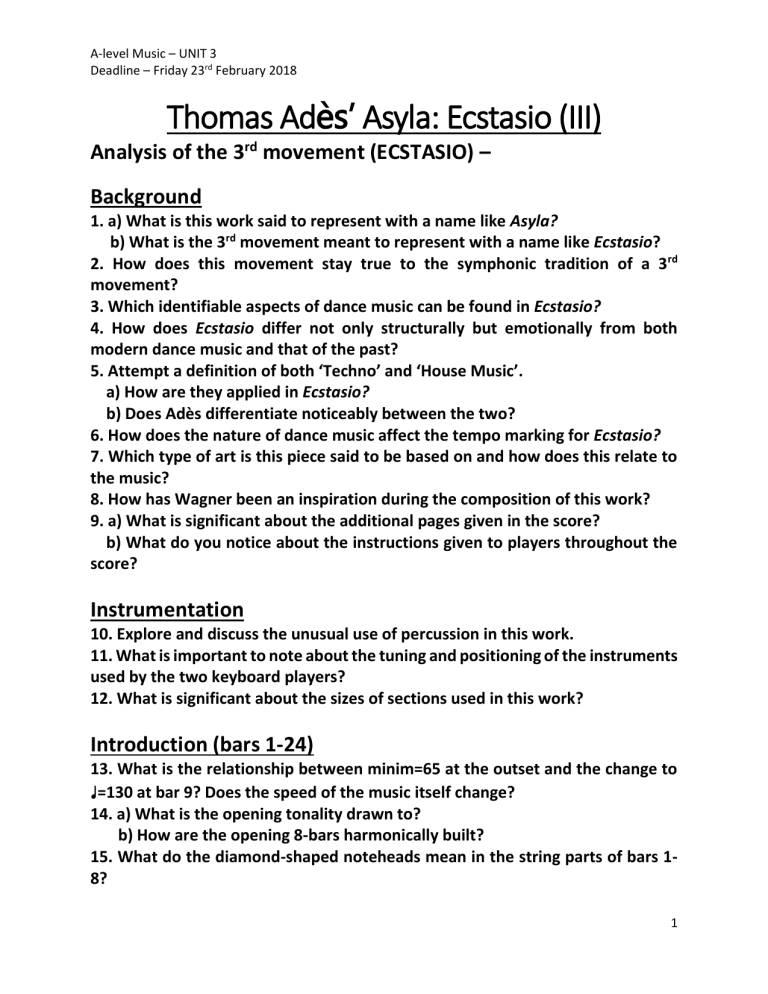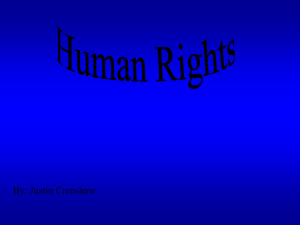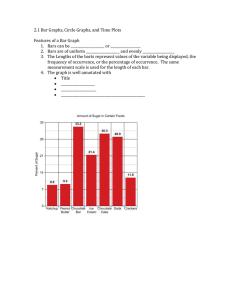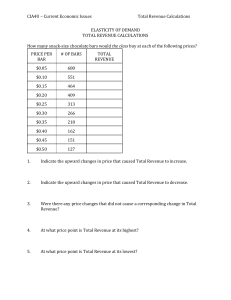
A-level Music – UNIT 3 Deadline – Friday 23rd February 2018 Thomas Adès’ Asyla: Ecstasio (III) Analysis of the 3rd movement (ECSTASIO) – Background 1. a) What is this work said to represent with a name like Asyla? b) What is the 3rd movement meant to represent with a name like Ecstasio? 2. How does this movement stay true to the symphonic tradition of a 3rd movement? 3. Which identifiable aspects of dance music can be found in Ecstasio? 4. How does Ecstasio differ not only structurally but emotionally from both modern dance music and that of the past? 5. Attempt a definition of both ‘Techno’ and ‘House Music’. a) How are they applied in Ecstasio? b) Does Adès differentiate noticeably between the two? 6. How does the nature of dance music affect the tempo marking for Ecstasio? 7. Which type of art is this piece said to be based on and how does this relate to the music? 8. How has Wagner been an inspiration during the composition of this work? 9. a) What is significant about the additional pages given in the score? b) What do you notice about the instructions given to players throughout the score? Instrumentation 10. Explore and discuss the unusual use of percussion in this work. 11. What is important to note about the tuning and positioning of the instruments used by the two keyboard players? 12. What is significant about the sizes of sections used in this work? Introduction (bars 1-24) 13. What is the relationship between minim=65 at the outset and the change to ♩=130 at bar 9? Does the speed of the music itself change? 14. a) What is the opening tonality drawn to? b) How are the opening 8-bars harmonically built? 15. What do the diamond-shaped noteheads mean in the string parts of bars 18? 1 A-level Music – UNIT 3 Deadline – Friday 23rd February 2018 16. What does the term poch. espr. mean in bar 9? 17. What does the G♭ instruction mean in the harp part of bar 10? 18. From the end of bar 12, there are regular repeated rhythmic patterns in percussion 3 & 4. In what way are the two rhythmic patterns related to one another? 19. a) What effect does the straight mute give in the piccolo trumpet part in bar 12? b) How would the sound of the cup mute differ in the trumpet parts of bar 21? 20. What is significant about the use of the D-C# interval used in the winds and brass in bars 12-13 and again in bars 16-17? 21. What is a crotales that enters in bar 17? 22. a) What effect would the hi-hat instruction in bar 17 have? b) What does the term damp mean in bar 17? c) What does the term l.v. mean in bar 17? 23. What effect does a harp harmonic give (bar 17)? 24. Why would the C# in bar 18 be particularly difficult for the flutes to play? 25. a) What is a rototom used in bar 18? b) What is significant about the hi-hat line in bar 20? c) Which unusual percussion instrument is introduced in bar 24? 26. What does the cross (+) symbol mean in the horn parts from bar 21? 27. What does the string technique sul pont mean in bar 24? Section A1 (bars 25-83) 28. What is the overall tonal centre of this section? 29. a) Which interesting harmonic feature is used in the cellos and 2nd violins from bar 25? b) What is unusual about the register of the pedal points held in the strings at bars 25-32? 30. Why would the double basses be instructed to put down bows in bar 25? 31. What effect would the use of a cup mute have in the trumpet parts of bar 25? 32. Why would the passage in the 1st violins from bar 25 be quite a challenge to play? 33. Although the idea heard in the wind and brass at bars 25-32 is repeated in regular 2-bar phrases, the rhythmic construction of the phrase itself is not regular. Define why. 2 A-level Music – UNIT 3 Deadline – Friday 23rd February 2018 34. Comment on the orchestration of the 2-bar phrase at bars 25-32. What is unusual about it? 35. a) How does the composer show practical understanding in bars 28-29? b) And again, in bar 83? 36. What effect would the instruction bells up and bells down have in the clarinet parts from bars 33-34 onwards? 37. What is important to note about the piano chord in bars 32-33? 38. How is the D pedal articulated and felt from bar 33 in the double basses? 39. How should the term non div. be interpreted in bar 34? 40. Comment on how the irregular ostinato heard in the double basses at bars 41-48 is structured. 41. What kind of harmony can be heard when it is introduced into the repeated phrase between bars 49-56? 42. How is the tessitura of the orchestra enriched and enhanced in bar 56? 43. What is unusual about the choice of percussion in bar 57? 44. How would the instructions of the double bass parts in bars 57-58 be interpreted? 45. What is the significance of the down bow in the strings in bar 64? 46. The hi-hats employ a single-stroke roll in bar 65. How would this be played? 47. What effect would the dead centre timpani instruction have in bar 66? 48. What is different about the kind of harmony used in the repeated phrase at bars 66-74 to previous versions of the repeated phrase? 49. What does the term martellato possibile à due mani mean in the piano part of bar 66? 50. What does the term Bartok pizzicato refer to in the strings from bar 66? 51. Where has the tonality shifted to in bar 67? 52. a) What does the horn instruction cuivré mean at bar 72? b) What about the horn instruction quasi bouchés in bar 81? 53. Why is the choke cymbal played specifically with snare drum sticks in bar 83? Section A2 (bars 84-115) 54. How has the composer changed the shape of the melody at bars 84-85 from that heard at bars 74-76? What process has it gone through? 55. What unusual playing techniques are the clarinets using from bar 86 and the horns from bar 111b and how would this be achieved? 56. What is the overall tonality of this section? 57. What effect would be given by pizz. behind the bridge in the cellos at bar 84? 3 A-level Music – UNIT 3 Deadline – Friday 23rd February 2018 58. What does the crudo instruction mean in the trumpet part in bar 86? 59. Bars 91-92 is an example of additive rhythm. What does this term mean? 60. What does the term secco mean at bar 97? 61. What devices does the composer use to vary the repeats of the different phrases in the passage between bars 97-110? 62. Which unusual string techniques are being used in bars 111-112? 63. Bars 111-112 consist of many bars of music. Why are they given just one bar number each and how are the players meant to know what to do? 64. What is meant by the term brassy in the trumpet part in bar 111b? 65. Explain what a polyrhythm is. 66. a) Which instrument is an anchor of this section for others to follow? b) What is this instrument imitating at this point? 67. What finally happens in bar 113? Section B (bars 116-148) 68. How does the composer turn a simple series of 8-chords, heard at bars 116123, into an active and busy orchestral texture? 69. Identify three different ostinati from the passage between bars 116-148. What technique is being used in the horns and later in the trombones between bars 116-131? 70. a) What does the string technique pizz. alla chitarra mean, followed by the arrows from bar 116? b) What effect would the open string instruction give in the violas from bar 116? c) What does the string technique sul tasto mean, seen in bar 120? d) What is unusual about the instructions given to the double basses in bar 120? 71. How should the wind and brass players perform when they see the term breath only? 72. Which extended technique is employed in the percussion section in bar 120? 73. What is inventive about the use of the clarinets in bar 121? 74. How does the geophone work that is introduced in bar 121? 75. a) What would be the effect created by the pedal instruction in bar 124? b) Likewise, the effect created with the percussion instructions in bar 128? 76. What is a sizzle cymbal that is used from bar 130 and how does it produce its sound? 4 A-level Music – UNIT 3 Deadline – Friday 23rd February 2018 77. What effect does the harmon mute have on the sound of the brass from bar 132? 78. Why would Adès instruct the double basses to play pizz. two hands in bar 132? 79. What does the term col legno battuto mean in the strings in bar 140? 80. a) What is the desired sound that the composer wants when he instructs the double bass players to play all with open low D from bar 140? b) What does the term l.h. (thud) mean in the same part at bar 140? Section C (bars 149-184) 81. What is significant about the mood of this section? 82. Which key is this section rooted in? 83. What is unusual about the parts for the violins, violas and cellos from bars 149-172? 84. What is a rimshot as instructed in the percussion parts of bar 149? 85. How is a continuous semiquaver pattern achieved throughout this section? 86. Discuss the use of harmony in bars 157-158, particularly the horns & trumpets. 87. What does the term rinforzato mean in bar 165? 88. How does the tonality of the woodwinds compare to that of the piano from bar 173? 89. What happens to the texture of the strings in bar 176? 90. What is significant about bar 179 for the percussion section? 91. What does the term velato mean in bar 182? Coda (bars 185-221) 92. What are the differences in the style of music found in the Coda to what has gone before? 93. a) What effect would the triangle beaters have on the tubular bells in bar 186? b) How would the tremolo be played in the cymbal part of bar 192? c) How should the harp chord be played in bar 192? 94. What relationship does the harmony in bars 200-204 have to Wagner’s opera Parsifal? 95. What does the term isterico mean in bar 205? 96. What does the dynamic symbol mean in the penultimate bar? 97. What aspect of the notes that make up the final chord relate to the harmony of the rest of Ecstasio? 5 A-level Music – UNIT 3 Deadline – Friday 23rd February 2018 Tonality 98. Which sections of Ecstasio have fixed unambiguous tonal centres? 99. What elements in the layout of the score in the Introduction make it difficult to identify the main tonal centre? 100. Does the composer ever use key signatures, or are we left to identify the various different tonal centres for ourselves? Texture & Sonority 101. Which particular features of Ecstasio’s orchestration makes it different from more traditional orchestral scores? 102. What register of the strings is particularly exploited in Ecstasio and what technique is frequently used to aid this? 103. It is relatively rare to find extended solos for one particular instrument in Ecstasio. What technique does Adès employ to share the material throughout the orchestra? Harmonic Language 104. How might the use of harmonic rhythm be described in Ecstasio? In what way does this relate to the use of harmonic rhythm as found in much dance music? 105. Give examples of passages where harmony is almost dispensed with altogether. What type of textures replace it? 106. What interval particularly is prominent in Adès’ use of harmony? Give some examples of where it can be found. Rhythm & Metre 107. What particularly unusual metre is found in Ecstasio and how does it work in relation to the metre that proceeds it? 108. In Ecstasio, many passages almost fall into 8-bar periods. How does Adès sometimes slightly curtail these passages? Dynamics 109. What are the main characteristics of the way dynamics are used in dance music in general? 110. How does the composer use dynamics in Ecstasio to make the large-scale structure clear? 6




